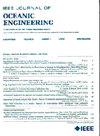Evaluation of the Covertness of Sound Signals Mimicking Those of Marine Mammals
IF 3.8
2区 工程技术
Q1 ENGINEERING, CIVIL
引用次数: 0
Abstract
To address the requirements for bionic covert underwater acoustic communication, this study introduces an evaluative methodology for assessing the concealment of sound signals that mimic those produced by marine mammals. Within the realm of bionic communication, the degree of covert effectiveness is predicated on the similarity between the synthetic sounds, which are embedded with information, and the natural sounds emitted by marine mammals. Higher fidelity in replicating authentic marine mammal acoustics correlates with enhanced stealth capabilities of the synthetic signals. Given the stringent requirements for information concealment in bionic covert underwater acoustic communication, it is imperative to assess the bionic stealth or the biomimetic efficacy of synthetic marine mammal sounds. This research aims to devise and implement an evaluative framework for the stealth of bionic signals, leveraging advanced methodologies such as feature engineering and audio fingerprinting, applied to bionic signal data derived from an array of marine mammals. The proposed evaluation framework within this article quantifies the covert effectiveness of bionic signals corresponding to the acoustics of various marine species, thereby providing a comprehensive measure of biomimetic fidelity and stealth performance. The outcomes of the evaluation elucidate the degree of resemblance between the synthetic bionic signals and the authentic sounds produced by marine mammals. A higher score indicates a minimal discrepancy between the synthetic and original marine mammal sounds, thereby denoting superior biomimetic accuracy and enhanced stealth of the bionic signals.模拟海洋哺乳动物声音信号的隐蔽性评价
为了满足仿生隐蔽水下声学通信的要求,本研究介绍了一种评估方法,用于评估模仿海洋哺乳动物发出的声音信号的隐蔽性。在仿生通信领域,隐蔽效果的好坏取决于内含信息的合成声音与海洋哺乳动物发出的自然声音之间的相似度。复制真实海洋哺乳动物声音的保真度越高,合成信号的隐蔽能力就越强。鉴于仿生隐蔽水下声学通信对信息隐蔽性的严格要求,评估合成海洋哺乳动物声音的仿生隐蔽性或生物仿生功效势在必行。本研究旨在利用特征工程和音频指纹识别等先进方法,设计并实施仿生信号隐身评估框架,并将其应用于从一系列海洋哺乳动物中提取的仿生信号数据。本文提出的评估框架量化了与各种海洋物种的声学特征相对应的仿生信号的隐蔽性,从而为生物仿真和隐身性能提供了一个全面的衡量标准。评估结果阐明了合成仿生信号与海洋哺乳动物发出的真实声音之间的相似程度。得分越高,表明合成信号与原始海洋哺乳动物声音之间的差异越小,从而表明仿生信号的生物仿真精度越高,隐身性能越强。
本文章由计算机程序翻译,如有差异,请以英文原文为准。
求助全文
约1分钟内获得全文
求助全文
来源期刊

IEEE Journal of Oceanic Engineering
工程技术-工程:大洋
CiteScore
9.60
自引率
12.20%
发文量
86
审稿时长
12 months
期刊介绍:
The IEEE Journal of Oceanic Engineering (ISSN 0364-9059) is the online-only quarterly publication of the IEEE Oceanic Engineering Society (IEEE OES). The scope of the Journal is the field of interest of the IEEE OES, which encompasses all aspects of science, engineering, and technology that address research, development, and operations pertaining to all bodies of water. This includes the creation of new capabilities and technologies from concept design through prototypes, testing, and operational systems to sense, explore, understand, develop, use, and responsibly manage natural resources.
 求助内容:
求助内容: 应助结果提醒方式:
应助结果提醒方式:


